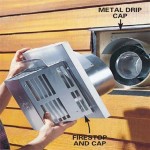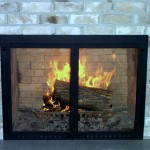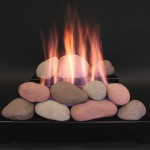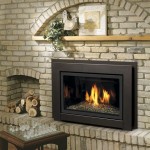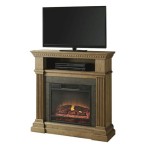Painting a Brick Fireplace: A Comprehensive Guide
A brick fireplace, a classic architectural feature, can transform the ambiance of a living space. However, over time, the aesthetic appeal of brick may diminish, prompting homeowners to consider alterations. Painting a brick fireplace offers a cost-effective and impactful method to refresh its appearance, complement evolving interior design schemes, and address issues such as soot stains or outdated color palettes. This article provides a comprehensive guide to painting a brick fireplace, outlining the necessary preparation, materials, application techniques, and considerations for achieving a professional and long-lasting result.
Before embarking on the painting process, careful planning and preparation are crucial. The success of the project hinges on thoroughly cleaning the brick surface, selecting appropriate materials, and understanding the specific characteristics of the fireplace. Neglecting these preliminary steps can lead to adhesion problems, uneven coverage, and ultimately, an unsatisfactory outcome. The following sections detail the essential aspects of preparing a brick fireplace for painting.
The decision to paint a brick fireplace is a significant one, as reversing the process can be challenging. Therefore, carefully consider the long-term aesthetic goals and ensure that painting aligns with the overall design vision for the room. It is also advisable to consult with a professional interior designer or contractor to assess the feasibility of the project and discuss potential challenges.
Key Point 1: Thorough Cleaning and Preparation of the Brick Surface
The first and arguably most important step is to thoroughly clean the brick surface. Years of soot accumulation, dust, and grime can prevent paint from adhering properly, leading to peeling and chipping. The cleaning process should involve several stages, starting with dry brushing and progressing to more intensive methods.
Begin by using a stiff-bristled brush, such as a wire brush or masonry brush, to remove loose debris, dust, and soot from the brick surface. Pay particular attention to crevices and mortar joints, where grime tends to accumulate. Vacuum the entire area with a shop vacuum to remove any remaining particles. This initial cleaning step is essential for creating a clean surface for subsequent cleaning and painting.
Next, prepare a cleaning solution using a mixture of water and trisodium phosphate (TSP). TSP is a powerful degreaser and cleaner that effectively removes soot, grease, and other stubborn stains from brick. Follow the manufacturer's instructions carefully when mixing the solution, and wear appropriate protective gear, including gloves and eye protection, as TSP can be irritating to the skin and eyes.
Apply the TSP solution to the brick surface using a sponge or scrub brush. Allow the solution to dwell for several minutes to loosen the dirt and grime. Then, scrub the brick thoroughly, paying particular attention to heavily soiled areas. Rinse the surface thoroughly with clean water to remove any remaining TSP residue. It is crucial to ensure that all TSP residue is removed, as it can interfere with paint adhesion.
Allow the brick surface to dry completely before proceeding to the next step. This may take several hours or even overnight, depending on the humidity and temperature. Use a moisture meter to verify that the brick is completely dry before applying primer or paint. Applying paint to a damp surface can trap moisture, leading to blistering and peeling.
Once the brick is dry, inspect the surface for any cracks or damage. Fill any cracks or imperfections with a masonry patching compound. Allow the patching compound to dry completely according to the manufacturer's instructions, and then sand it smooth to blend with the surrounding brick surface. This step is essential for creating a smooth and uniform surface for painting.
Key Point 2: Selecting the Appropriate Primer and Paint
Choosing the right primer and paint is critical for achieving a durable and aesthetically pleasing finish. The selection process should consider the porous nature of brick, the potential for moisture exposure, and the desired aesthetic effect. Using the wrong type of primer or paint can lead to adhesion problems, moisture damage, and an unsatisfactory appearance.
For priming brick, an alkali-resistant primer is highly recommended. Brick is a porous material with a high pH level. Alkali-resistant primers are designed to withstand the alkalinity of brick and prevent the paint from being damaged by the alkaline salts in the brick. Latex-based primers are generally a good choice, as they are breathable and allow moisture to escape from the brick.
Apply the primer evenly to the brick surface using a brush, roller, or paint sprayer. Ensure that the primer penetrates into the pores of the brick to provide a solid base for the paint. Allow the primer to dry completely according to the manufacturer's instructions before applying the paint. Two coats of primer may be necessary for heavily stained or porous brick.
For painting the brick fireplace, latex-based paints are generally preferred for their durability, ease of application, and low odor. Choose a paint with a matte or eggshell finish, as these finishes tend to hide imperfections and create a more natural look. Avoid using high-gloss paints, as they can accentuate the texture of the brick and create an unnatural appearance.
Ensure that the paint is specifically formulated for masonry surfaces. Masonry paints are designed to withstand the harsh conditions that brick fireplaces are exposed to, including heat, moisture, and soot. They are also formulated to adhere well to the porous surface of brick. Select a paint color that complements the overall design scheme of the room. Consider using neutral colors, such as white, cream, or gray, for a classic and timeless look. Alternatively, choose a bolder color to create a focal point in the room.
If the fireplace is a functional wood-burning fireplace, use a heat-resistant paint for the firebox area. Heat-resistant paints are specifically formulated to withstand high temperatures and prevent the paint from peeling or cracking. Follow the manufacturer's instructions carefully when applying heat-resistant paint.
Key Point 3: Application Techniques and Considerations
Proper application techniques are essential for achieving a smooth, even, and professional-looking paint job. The choice of application method, the number of coats, and the attention to detail all contribute to the final outcome. Rushing the application process or neglecting proper techniques can result in an uneven finish and a less-than-satisfactory result.
Before beginning to paint, protect the surrounding area with drop cloths and painter's tape. Cover the floor, walls, and any furniture that could be splattered with paint. Use painter's tape to mask off any areas that you do not want to be painted, such as the mantel or the surrounding wall trim. Proper preparation will save time and effort in the long run.
Apply the paint in thin, even coats using a brush, roller, or paint sprayer. A brush is ideal for painting mortar joints and crevices, while a roller is suitable for painting larger, flat surfaces. A paint sprayer can provide a smooth and even finish, but it requires more skill and experience to use effectively. If using a brush, use a high-quality brush with synthetic bristles. Apply the paint in long, even strokes, following the direction of the brick.
Allow each coat of paint to dry completely according to the manufacturer's instructions before applying the next coat. Two or three coats of paint may be necessary to achieve complete coverage and a uniform finish. Avoid applying thick coats of paint, as this can lead to drips, runs, and an uneven texture. Thin coats, properly dried, always yield the best results and longevity.
Pay attention to detail when painting around the edges and corners of the fireplace. Use a small brush to carefully paint these areas, ensuring that the paint is applied evenly and without drips. Remove the painter's tape carefully after the final coat of paint has dried, pulling it away at a 45-degree angle to prevent the paint from peeling.
After the paint has dried completely, inspect the fireplace for any imperfections or areas that need to be touched up. Use a small brush to touch up any areas that are missing paint or that have an uneven finish. Allow the touch-up paint to dry completely before using the fireplace. Follow these steps meticulously to ensure a paint job that elevates the fireplace and the entire room's aesthetic.
Consider the importance of ventilation during the painting process. Ensure the room is well-ventilated by opening windows and using fans to circulate air. This will help to reduce the odor of the paint and speed up the drying time. Good ventilation is particularly important when working with oil-based paints.
Furthermore, be mindful of the environmental conditions. Avoid painting in extremely hot or humid weather, as this can affect the drying time and quality of the paint. The ideal temperature for painting is between 60°F and 80°F, with low humidity.
Finally, always consult with a professional painter or contractor if unsure about any aspect of the painting process. A professional can provide valuable advice and guidance, ensuring that the project is completed safely and successfully.

30 Gorgeous Painted Brick Fireplace Ideas

7 Beautiful Ideas For Painting Interior Brick Fireplaces

How To Paint A Brick Fireplace The Right Way

Painting Brick Fireplace White A Renovation Story

How To Paint A Brick Fireplace What Use Home With Janny

How To Paint A Brick Fireplace Kippi At Home

How To Update A Brick Fireplace With Chalk Paint Diy Beautify Creating Beauty At Home

How To Paint A Brick Fireplace And The Best Use Måla öppen Spis Öppen Inredning Grå Färg

Paint Your Brick Fireplace In 2 Easy Steps Birkley Lane Interiors

How To Paint A Brick Fireplace And The Best Use Craftivity Designs

